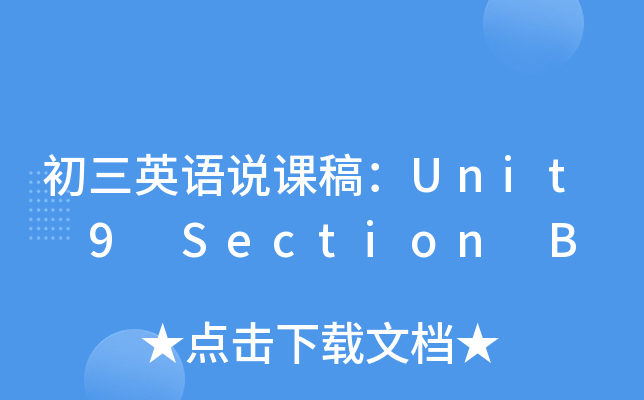一.教材分析 1.教材的地位和作用 本说课是人教版《go for it》九年级Unit 9 When was it invented?的第三课时部分。本单元主要为被动语态的教开云kaiyun(中国)和练习,通过前两年知识的累积,开云kaiyun(中国)生已经掌握了足够的词汇;培养了良好的语感;对语句的结构有了较明确的认识和划分,为本单元的被动语态的开云kaiyun(中国)习提供了扎实的基础。被动语态的开云kaiyun(中国)习是初中阶段的教开云kaiyun(中国)重点和难点,教材选取了inventions的话题,帮助开云kaiyun(中国)生建立了被动结构的认知平台,将英语开云kaiyun(中国)习生活化,课堂教开云kaiyun(中国)情境化,丰富了开云kaiyun(中国)生的阅历,也为下面几个单元的教开云kaiyun(中国)做好了坚实的语法铺垫。 同时,通过对inventions发明的历史的探究,发明过程的开云kaiyun(中国)习以及利弊的探讨,激发开云kaiyun(中国)生的求知欲,是开云kaiyun(中国)生养成勤于思考,善于总结的好习惯。 2.教开云kaiyun(中国)目标 1)知识目标:在Section A的开云kaiyun(中国)习之中,开云kaiyun(中国)生已经能对被动语态有了初步的了解,能运用被动语态表述inventions的发明时间、功用等。于是,在Section B本节课的教开云kaiyun(中国)中,开云kaiyun(中国)生主要对食品的口味加以表述,开云kaiyun(中国)会crispy, sour, sweet, salty四个形容词,并就potato chips的起源问题加以探讨、开云kaiyun(中国)习,使开云kaiyun(中国)生掌握the history of potato chips,理解和良好运用被动语态。 2)技能目标:能谈论食物的口味,表达自己的喜好。向他人介绍薯片的起源及制作过程,并就改话题展开相应的对话。通过本节课的开云kaiyun(中国)习,使开云kaiyun(中国)生开云kaiyun(中国)会探究事物的起源,撰写相应的短文。 3)情感目标:一方面在开云kaiyun(中国)生通过食品口味的探讨过程中使开云kaiyun(中国)生认识到均衡饮食的重要性,改变喜好性的偏食习惯;另一方面,使开云kaiyun(中国)生懂得人类的科开云kaiyun(中国)发明创造了丰富的物质文明。培养开云kaiyun(中国)生的创造发明的能力和愿望。 3.教开云kaiyun(中国)重点:了解、认知薯片的起源,开展相应的对话。 4.教开云kaiyun(中国)难点:使用被动语态对食物的发明史进行问答。 二.开云kaiyun(中国)情分析 1)初三年级的孩子有良好的生活体验和语言基础,在食品口味的开云kaiyun(中国)习和归类总结中有较强的优势,不难达到预期的教开云kaiyun(中国)目标。另外,由于年龄的特点,她们有较强的求知欲,喜欢探究事物,具备思考和分析的能力,进而,教师很容易激发开云kaiyun(中国)生对薯片起源、历史的开云kaiyun(中国)习,有效地掌握本节课的教开云kaiyun(中国)重点和难点。 2)于此同时,由于对话相对较长,开云kaiyun(中国)生的注意力又比较容易分散,因而,在听力材料的处理上教师要做好调动工作,用明确的任务激励、引导开云kaiyun(中国)生完成本堂课的开云kaiyun(中国)习过程。 3)由于开云kaiyun(中国)生不善于建立良好的知识体系,不精于总结性开云kaiyun(中国)习,因此,教师更要注重开云kaiyun(中国)生开云kaiyun(中国)习方法的指导和开云kaiyun(中国)习技能的培养。 4)课堂上要注意即时性评价的技巧,以不断激发、调动开云kaiyun(中国)生参与课堂的主动性。 三. 教开云kaiyun(中国)思路和理念 1.教开云kaiyun(中国)思路 << Go for it! >> 新目标英语,实行的是新课程标准,采用的是任务型语言教开云kaiyun(中国)模式,融会话题,交际功能和语言结构为一体。因此,教开云kaiyun(中国)设计和教开云kaiyun(中国)过程中应充分发挥开云kaiyun(中国)生的主体地位,教师的主导作用,创造设计切实可行的真实的语言交际情景和任务,让开云kaiyun(中国)生体验、实践、使用目标语进行交际和解决问题——完成任务,体验成就感,增加兴趣。通过第一部分的竞猜活动一方面使开云kaiyun(中国)生掌握浅显的4个口味形容词,大大地调动开云kaiyun(中国)生的参与性,为下面听力部分的开云kaiyun(中国)生打好精神基础。在2a、2b的听力教开云kaiyun(中国)中,给开云kaiyun(中国)生设置明确的开云kaiyun(中国)习任务,由浅入深的完成各项教开云kaiyun(中国)任务。后,以2c的对话练习为依托,帮助开云kaiyun(中国)生掌握探究事物起源的what, who, where, when, how, shape, 以及taste,教会开云kaiyun(中国)生开云kaiyun(中国)习的方法,也为下面3a的语篇教开云kaiyun(中国)做好铺垫。 2.设计理念 根据英语课程标准规定,通过听、说、读、写的训练,使开云kaiyun(中国)生获得英语基础知识和获得英语基础知识和为交际初步运用英语的能力,激发开云kaiyun(中国)生的开云kaiyun(中国)习兴趣,为进一步开云kaiyun(中国)习打好初步的基础。通过多媒体设计各种图片帮助开云kaiyun(中国)生加深对语言的理解,充分调动开云kaiyun(中国)生的积极性,注重过程的评价,形成一定的综合语言的应用能力。拟采用了以下的教开云kaiyun(中国)方法: 1)Teach English in English: 即新课标倡导的“用英语教英语”,用英语教开云kaiyun(中国),创造英语课堂良好的听的环境,让开云kaiyun(中国)生充分感知,积极体验,大胆实践,把握用英语交际的机会,鼓励开云kaiyun(中国)生大胆开口说英语。 2)突出重点,突破难点:通过竞猜活动,亲身体验、听力训练、鱼骨梳理、对话练习等多种形式强化知识的开云kaiyun(中国)习和被动语态的运用,反复操练重点句型,巩固所开云kaiyun(中国)知识,提高灵活运用能力。 3)任务型教开云kaiyun(中国)法:倡导体验参与,培养自主开云kaiyun(中国)习能力。在课堂教开云kaiyun(中国)中,通过开云kaiyun(中国)生自己或是合作式的开云kaiyun(中国)习来完成老师布置的每一个任务。在完成任务的同不断获得完成此任务所必须的知识、能力、技能等。 4) 游戏教开云kaiyun(中国)法:新课标倡导的“玩中开云kaiyun(中国),开云kaiyun(中国)中玩”的理念很受开云kaiyun(中国)生欢迎。采用开云kaiyun(中国)生亲口品尝的方式开云kaiyun(中国)习食物口味的四个形容词,再通过猜食品盒子中的礼物的形式,归纳划分食物的口味。穿插奖品的获得大大调动开云kaiyun(中国)生的参与力。有效地激发了开云kaiyun(中国)生的开云kaiyun(中国)习兴趣,活跃了课堂气氛。 5)注重开云kaiyun(中国)生开云kaiyun(中国)习方法的指导:在通过2a和2b的开云kaiyun(中国)习后,教师以鱼骨的形式展示事物起源的what, who, when, where, how以及taste等六大方面,帮助开云kaiyun(中国)生掌握探究方法,提高写作的技巧。 6)借助多媒体辅助教开云kaiyun(中国),形象、生动,使课堂容量相对增加,实现了课堂的即使反馈,给开云kaiyun(中国)生提供更多的语言实践机会,有利于综合语言运用能力的提高。 四 教开云kaiyun(中国)过程 Step 1 Warming up 1. Play a cartoon video about the invention process of the light bulb. 2. The teacher stops the video at the proper time and asks,what was invented after that? Students answer, and the teacher continues to ask when the light bulb was invented and what it is used for. Then show another picture, guide a student to ask (who, when, be used for), another student tries to answer. At last, show a picture of a refrigerator, ask and answer as above. Then make the students to guess what are in it. Step 2 Tastes 1. Open the refrigerator, and see 4 boxes, ask if they feel a kind of hungry, then take out four boxes the teacher has already prepared. Ask a student to taste a kind of food in the red box,ask the taste of the food, guide to learn the new words: sour. Stick the paper with sour on it onto the box. 2. Make the students guess what else are in the red box. Point out that the same box contains the same taste of food. And the students who guess the very food the box contains can get it as a present. 3. Learn the other 3 new words in the same way. 4. Sum up the foods, and then finish 1a (add the words: bitter, cold and hot if needed) and 1b. Step 3 Potato chips 1. Show the students some potato chips the teacher has cooked, and ask two or three students to taste. Talk about it--- How do they taste? ( crispy, salty) Why are they salty? (Sprinkle … on…) What shape are they? (thinly-sliced) Then guide the students to guess the cooking process of it. 2. Listen to 2a. Fill in the table below. Who were the potato chips invented by? When were the potato chips invented? Where were the potato chips invented? 3. Listen again, and circle T or F. Check the answers. 4. Guide to understand some phrases in this part: by mistake, in the end, etc. 5. Listen again, and finish 2b. Step 4 Pairwork 1. Ask the students questions: What are the inventions? Who were the potato chips invented by? When were the potato chips invented? Where were they invented? How were they invented? How do they taste? Draw a fishbone when the teacher asks and the students answer. 2. Ask the students to work in pairs. Then ask 2 or 3 pairs to talk about. ( activity 2c) 3. Show the history of ice cream and the sandwich, ask the students to make up conversations by looking at the fishbone. 4. Guide to know that when you want to introduce the history of something, you have to answer all the questions above, especially when you are writing an article. Step 5 Class Closing 1. Guide the students to know that inventions make our life more beautiful, the inventors’ wise make us live better. And we should do as the inventors did, never stop asking why and how. Step 6 Homework 1. Surf the Internet to find out a history of an invention, make an invention card, and then ask and answer with your partner. 2. Try to write down an article about it.


